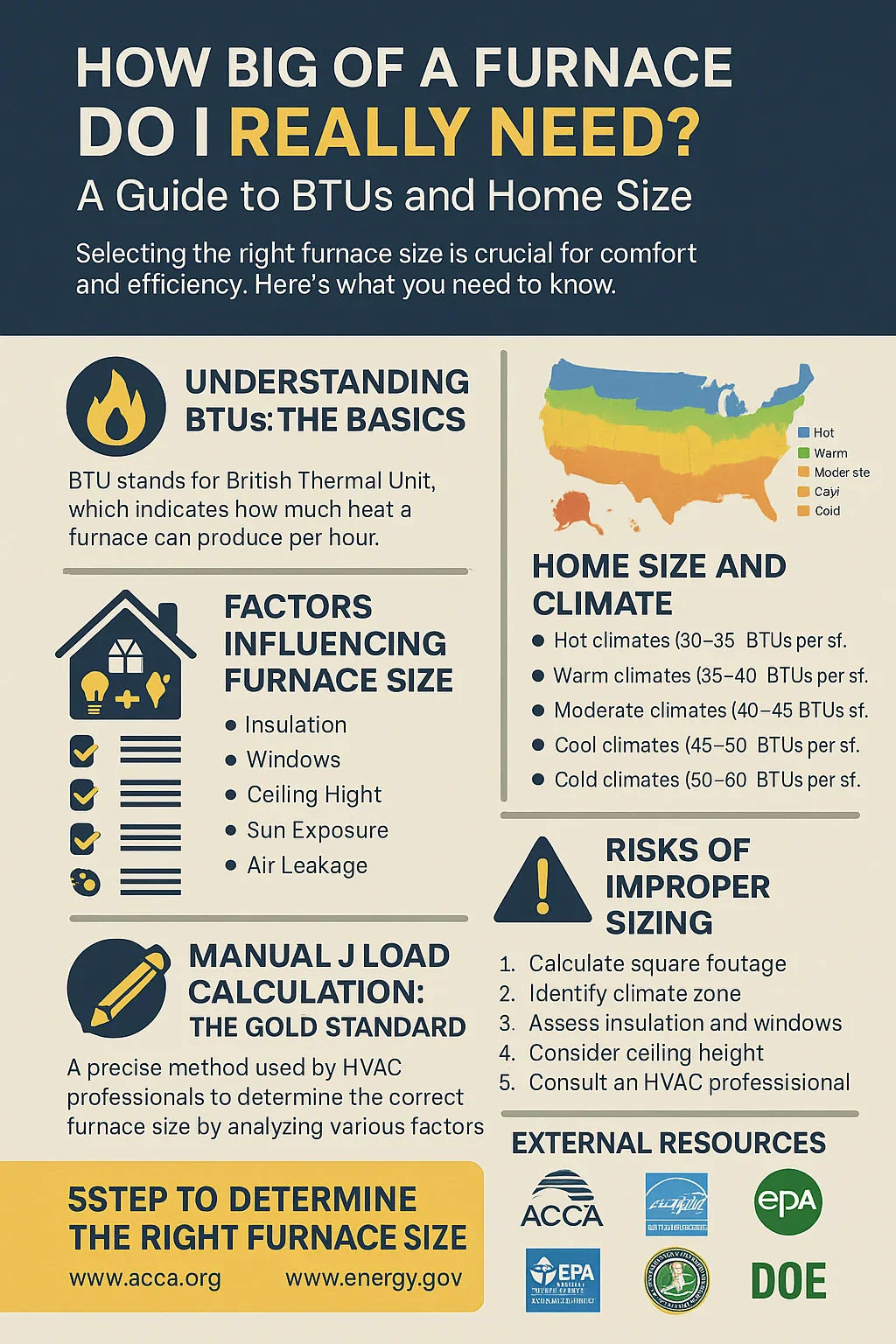📌 Introduction: The Importance of Proper Furnace Sizing
Selecting the right furnace size is crucial for ensuring comfort, energy efficiency, and the longevity of your heating system. An undersized furnace may struggle to heat your home adequately, while an oversized one can lead to short cycling, increased wear, and higher energy bills. This guide will help you understand how to determine the appropriate furnace size for your home.
🔥 Understanding BTUs: The Basics
BTU stands for British Thermal Unit, a measure of heat energy. In the context of furnaces, BTUs indicate the amount of heat a furnace can produce per hour. For example, a furnace rated at 80,000 BTUs can produce 80,000 BTUs of heat per hour.
🧮 Estimating Furnace Size Based on Home Size and Climate
A general rule of thumb is to allocate a certain number of BTUs per square foot, adjusted for your climate zone:
-
Hot climates (Zone 1): 30–35 BTUs per sq. ft.
-
Warm climates (Zone 2): 35–40 BTUs per sq. ft.
-
Moderate climates (Zone 3): 40–45 BTUs per sq. ft.
-
Cool climates (Zone 4): 45–50 BTUs per sq. ft.
-
Cold climates (Zone 5): 50–60 BTUs per sq. ft.
For instance, a 2,000 sq. ft. home in a moderate climate (Zone 3) would require approximately 80,000 to 90,000 BTUs. However, this is a rough estimate and doesn't account for other factors like insulation, window quality, and ceiling height.
🏠 Factors Influencing Furnace Size
Several elements can affect the heating requirements of your home:
-
Insulation Quality: Well-insulated homes retain heat better, potentially reducing the required furnace size.
-
Window Efficiency: Double or triple-pane windows can minimize heat loss.
-
Ceiling Height: Higher ceilings increase the volume of space to heat.
-
Sun Exposure: Homes with significant sun exposure may need less heating.
-
Air Leakage: Drafts and leaks can lead to heat loss, necessitating a larger furnace.
📏 Manual J Load Calculation: The Gold Standard
For an accurate assessment, HVAC professionals use the Manual J Load Calculation, developed by the Air Conditioning Contractors of America (ACCA). This method considers various factors, including:
-
Home orientation
-
Number and type of windows and doors
-
Insulation levels
-
Air infiltration rates
-
Occupancy and appliance heat gains
By performing a Manual J calculation, you can ensure your furnace is neither oversized nor undersized, leading to optimal performance and energy efficiency.
⚠️ Risks of Improper Furnace Sizing
-
Oversized Furnace:
-
Short cycling, leading to increased wear and tear
-
Higher initial costs and energy bills
-
Inconsistent temperatures and reduced comfort
-
-
Undersized Furnace:
-
Inability to maintain desired temperatures
-
Continuous operation, increasing energy consumption
-
Accelerated wear due to overuse
-
🛠️ Steps to Determine the Right Furnace Size
-
Calculate Your Home's Square Footage: Measure each room and sum the areas.
-
Identify Your Climate Zone: Refer to climate zone maps to determine your region.
-
Assess Insulation and Window Quality: Better insulation and windows can reduce BTU needs.
-
Consider Ceiling Height and Home Layout: Open floor plans and high ceilings may require more heating capacity.
-
Consult a Professional: Engage an HVAC expert to perform a Manual J Load Calculation for precise sizing.
🧰 Tools and Resources
-
Furnace Size Calculators: Online tools can provide preliminary estimates based on your inputs.
-
HVAC Professionals: Certified technicians can offer detailed assessments and recommendations.
-
Energy Efficiency Programs: Look for local or federal programs offering incentives for energy-efficient furnace installations.
📚 External Resources
For further information and tools:
📝 Conclusion
Determining the correct furnace size is a balance of various factors, including your home's size, climate, insulation, and more. While general guidelines can provide a starting point, consulting with HVAC professionals and utilizing tools like the Manual J Load Calculation ensures optimal comfort, efficiency, and system longevity.
In the next article we will know about: Is an R-32 Gas Furnace Safe? What You Should Know Before Buying







